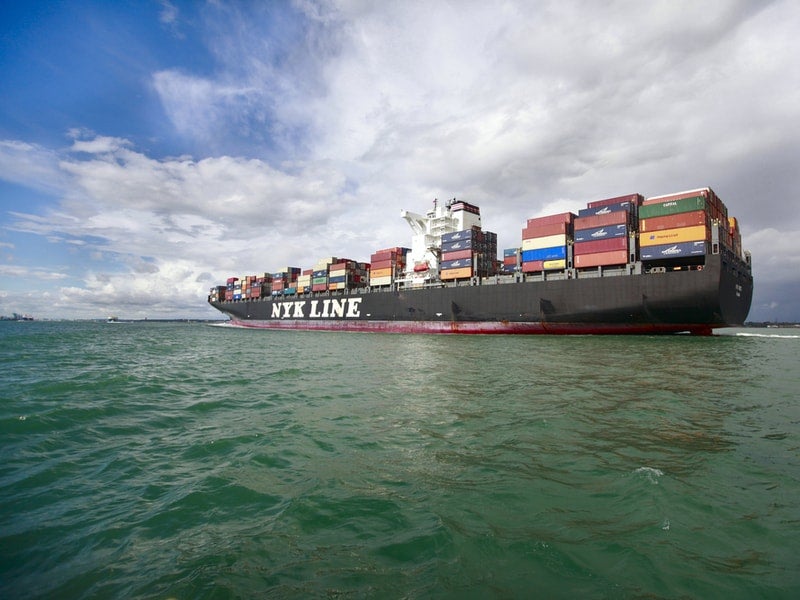Japanese ocean shipping and transport company, Nippon Yusen Kabushiki Kaisha (NYK Line) (JPX:9101) has today reported a loss of approximately US$400 million (Japanese Yen 44.5 billion) for the year ended March 31, 2019. Following the red ink bloodbath, the company has replaced the chairman, president and representative directors.
“These losses were recorded mainly due to the negative impact as well as extraordinary losses of the liner trade and air cargo transportation segment and due to related expenses for structural reforms of the dry bulk business. We are viewing the results of this year seriously,” the company said in a statement.
It added that the senior leaders met the Nomination Advisory Committee and resolved to change the senior leadership today.
Former chairman Yasumi Kudo will now fill a “special advisor” position. Former president Tadaaki Naito will take the chairman’s role and will also be a director. Former executive vice-president Hitoshi Nagasawa has been appointed as the president. Director and senior managing corporate officer Eiichi Takahashi has been made “representative director” and remains in the senior managing corporate officer role. Chief outside director Yukio Okamoto is now out. Replacing Okamoto in that role is Yoshihiro Katayama.
New president Nagasawa, 61, joined the company in April 1980. He became general manager of the LNG Group in April 2004, a managing corporate officer in April 2009, senior managing corporate officer in April 2013 and executive VP April 2018.
60-year old Takahashi joined the company in April 1982, became the general manager of accounting in April 2010 and was appointed as a director and managing corporate officer in June 2016. He was appointed as senior managing corporate officer, in addition to a directorship, in April 2018.
Revenues for NYK fell by 16.2 percent from JPY 2.18 trillion (US$19.54 billion) in the 12 months ended March 2018 to stand at JPY 1.83 trillion by the year ending March 2019. Operating profit suffered an even greater proportional fall, down by 60.2 percent from JPY 27.8 billion (US$248.8 million) by the year ending March 2018 to 11.09 billion by the year ending March 2019.
Total assets of NYK stood at JPY2,001 billion, a decrease of just under JPY70 billion compared to the end of the previous fiscal year. Total liabilities decreased by JPY 3.4 billion to stand at JPY1,479.9 billion. The group’s debt to equity ratio rose to 2.15.
Current assets stand at JPY 564,597 million while current liabilities stand at JPY 516,959 million yen, which gives it a current ratio of 1.09.
Liner trade revenues fell by 58.6 percent by the end of the financial year to stand at JPY 286.3 billion. Air cargo revenues fell by 41 percent to 56.7 billion yen. Logistics revenues… rose 2.6 percent to JPY525.8 billion. Bulk shipping revenues increased by 5.8 percent to JPY841.3 billion.
Commenting on the results, the group noted that, in the container shipping division, the newly established shipping line “One,” immediately suffered problems with a drop in liftings and slot utilization. That improved over the year but empty container repositioning costs owing to insufficient liftings “placed pressure on the bottom line”. Freight rates were said to be favorable, particularly on the North America trade. Bunker prices also hurt the bottom line. There were also higher than expected costs from the termination of the NYK Line container business.
On the air cargo side, volumes were badly hurt after the company was forced to ground all of its aircraft because of an air safety order from the Japanese minister of transport. The group said that there had been “improper maintenance work conducted in the past” by a consolidated subsidiary.
The group’s logistics division received a boost from urgent demand for air freight owing to stranded cargoes from typhoons. Ocean freight volumes were “particularly strong” owing to the political friction between Washington and Beijing. Robust U.S. demand and “firm” volumes in Europe also helped.
Automobile shipping volumes were strong to north America and Europe but volumes elsewhere were “sluggish” and total finished car volumes declined. NYK worked to overcome the problems through “slow-steaming” (sailing ships more slowly produces a big gain in fuel savings) and through trying expand logistics proposals.
Dry bulk shipping suffered from new ships exceeding scrapped ships, “the excess capacity has not been fundamentally eliminated,” NYK said. Volumes of iron ore, coal and grain were firm in the first half of the year but slowed in the second half. NYK sought to offset by reducing costs through greater efficiency, reducing ballast voyages and finding “innovative cargo combinations and ship deployments.”
Wet bulk shipping (crude oil) improved as tonnage supply-demand came back into balance owing to scrapping of older vessels and “vigorous winter shipping volumes”. LNG shipping was supported by long term contracts; liquefied petroleum gas shipping held up despite excess tonnage owing to increased U.S. to Asia volumes and the floating production storage and offloading vessels (LNG trades) “operated steadily”. Bulk shipping was therefore able to achieve a higher profit.
Looking forward, NYK foresees greater profitability on lower revenue as it expects business performance in the ocean liner and air cargo trades to “significantly improve”. NYK expects ocean box shipping company “One” to recover liftings and slot utilization that were lost immediately after the beginning of operations. NYK expects volumes in the dry and wet bulk markets to improve and, in the automobile business, that business improvement measures will be executed. NYK adds that “efforts will be made” to improve cargo volumes in air and ocean freight forwarding.
NYK is forecasting profits of JPY26 billion by the year ending March 31, 2020.










